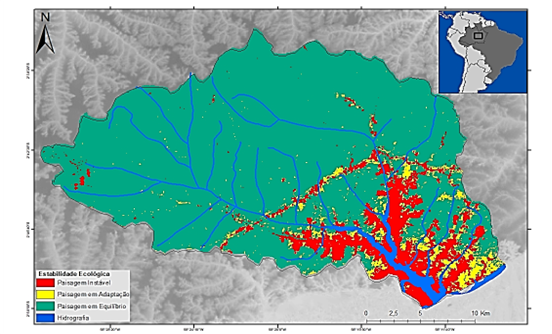Abstract
The research addresses the origin of the Campinaranas and the primary characteristics of this Amazonian landscape. The results presented herein are part of a doctoral thesis entitled: The Relationship between the Campinaranas Forests and the Ecological Resilience Process (Amazon, Brazil). The Campinaranas are atypical landscapes in the Amazon, dispersed in the Dense Ombrophilous Forest. They have sandy soils and small-scale vegetation. Various methodological procedures were used to evidence the Campinaranas' origin, based on field research, in which five sample collection points were selected in the Sanabani river basin in Silves, Amazonas - Brazil. These samples enabled an understanding of the main particularities of the Campinaranas (soil, vegetation, and human interventions) through soil analysis (soil chemistry and physics), comparative analysis, a vegetation inventory, and classification of the environment. The main objectives were: 1) To quantify the soil and vegetation variables of the Campinaranas in the study area; 2) To identify the fundamental interventions in the Campinaranas areas and the origin of this environmental system. The results demonstrate that the Campinaranas are diverse environments resulting from the forest's ecological resilience after an intervention event. The analyses verify that environmental changes modify the soil granulometry and, consequently, the entire ensuing structure.
References
AB’ SABER, A. N. O Domínio Morfoclimático Amazônico. In: Leituras indispensáveis. São Paulo: Ateliê Editorial, 2000.
ABREU, N. R. P; VIEIRA, A. F. S. G. Análise das Diferenças Florísticas e os Diferentes Tipos de Solo das Rodovias Am 330 e Am 363, em Silves e Itapiranga, Amazonas. Geosaberes, Fortaleza, v. 10, n. 21, p. 1-13, 2019. https://doi.org/10.26895/geosaberes.v10i21.720.
ABREU. N. R. P. A. Relação entre as Florestas de Campinaranas e Processo de Resiliência Ecológica (Amazônia, Brasil). Tese de Doutoramento. Universidade de Lisboa. Lisboa-Portugal, 2023.
BUENO, G. T. Appauvrissement et podzolisation des latérites du baissin du Rio Negro et gênese dês Podzols dans le haut bassin amazonien. Doutorado em Geografia. Rio Claro, 191p., 2009.
DIEGUES, A. C. O Mito Moderno da Natureza Intocada. Editora Hucitec, São Paulo, 6 ed., 2008. https://doi.org/10.1590/S1678-53202008000100010
DUCKE, A.; BLACK, G. A. Notas sobre a fitogeografia da Amazonia brasileira. Boi. Técnico do IAN, Belém, p. 1-62, 1954.
EMBRAPA. Serviço Nacional de Levantamento e Conservação de Solos (Rio de Janeiro, RJ). Manual de métodos de análise de solo. Rio de Janeiro, 1997.
EMBRAPA. Serviço Nacional de Levantamento e Conservação de Solos (Belém-PA). Avaliação da Aptidão Agrícola do Município de Silves – Estado do Amazonas. Belém, 2003.
FERREIRA, C. A. C. Análise comparativa do ecossistema campina na Amazônia brasileira. Tese (doutorado). INPA, Manaus, 2009.
GUIMARÃES, F.S; BUENO, G.T. As Campinas e Campinaranas Amazônicas. Caderno de Geografia, São Paulo, v. 26, n. 45, p. 113, 2016.https://doi.org/10.5752/P.23182962.2016v26n45p113.
HOLLING, C. S. Resilience and stability of ecological systems, Annual Review of Ecological Systems, p. 1-23. 1973. https://doi.org/10.1146/annurev.es.04.110173.000245
IBGE – Instituto Brasileiro de Geografia e Estatística. Manual técnico da vegetação brasileira: Sistema fitogeográfico: inventário da formações florestais e campestres: técnicas e manejo de coleções botânicas: procedimentos para mapeamentos. Rio de Janeiro: IBGE, 2012. 272p.
JANZEN, D. H. Tropical blackwater rivers, Animais and mast fruiting by the Dipterocarpaceae. Biotropica, p. 69-103, 1974. https://doi.org/10.2307/2989823
KLINGE, H. Podzol soils in the Amazon Basin. Journal of Soil Science, p. 95-103, 1965. https://doi.org/10.1111/j.13652389.1965.tb01423.x
LUIZÃO, R .C. C; LUIZÃO, F. J; PAIVA, R. Q; MONTEIRO, T. F; SOUSA, L. S; KRUIJT, B. Variation of carbon and nitrogen cycling processes along a topographic gradient in a central Amazonian forest. Global Change Biology, p. 692-600, 2004. https://doi.org/10.1111/j.1529-8817.2003.00757
LISBOA, P. L. Observações gerais e revisão bibliográfica sobre as campinas amazônicas de areia branca. Acta Amazônica, v. 5, n. 3, p. 211-223, 1975. https://doi.org/10.1590/1809-43921975053211
MAFRA, A. L; MIKLOS, A. A. W; VOLKOFF, B.; MELFI, A. J. Pedogênese numa sequência latossolo-espodossolo na região do alto rio Negro, Amazonas. Revista Brasileira de Ciência do Solo, n. 26, p. 381-394, 2002. https://doi.org/10.1590/S010006832002000200012.
MENDONÇA, B. A. F. Campinaranas Amazônicas: Pedogênese e a relação solo-planta, Viçosa-MG, 2011.
MENDONÇA, B. A. F; FERNANDES FILHO, E. I; SCHAEFER, C. E. G. R; SIMAS, F. N. B; PAULA, M. D. Os solos das campinaranas na Amazônia brasileira: ecossistema arenícolas oligotróficos. Ciência Florestal, Santa Maria, v. 25, n. 4, p. 827-839, 2015. https://doi.org/10.5902/1980509820581.
PRANCE, G. T. Estudos sobre a vegetação das campinas amazônicas-I: Introdução a uma série de publicações sobre a vegetação das campinas amazônicas. Acta Amazônica, v. 5, n. 3, p. 207-209, 1975.
PRANCE, A. G; ALBUQUERQUE, B. W. P. Estudos sobre a vegetação das campinas amazônicas-III: A vegetação lenhosa da campina da reserva biológica INPA-SUFRAMA (Manaus-Caracaraí, Km 62). Acta Amazônica, v. 5, n. 3, p. 225-246, 1975. https://doi.org/10.1590/1809-43921975053207.
PRANCE, G. T. E.; SCHUBART, H. O. R. Notes on the Vegetation of Amazonia I. A Preliminary Note on the Origin of the Open White Sand Campinas of the Lower Rio Negro. Brittonia, p. 60-63, 1978. https://doi.org/10.1590/1809-43921975053225.
PRANCE, G. T. The Diversity of the Amazon Flora. Royal Institution Proceedings, p. 169–195, 1992. https://doi.org/10.2307/2806458.
ROOSEVELT, A. C. The Amazon and the Anthopocene: 13.000 years of human influence in a tropical raiforest. Elsevier, p. 2213-3054. https://doi.org/10.1016/j.ancene.2014.05.001
SPRUCE, R. J. B. Notes of a botanist on the Amazon and Andes. London, R . Wallace, 1908.

This work is licensed under a Creative Commons Attribution 4.0 International License.
Copyright (c) 2023 Nadia Rafaela de Abreu, Eusébio Joaquim Marques dos Reis, Antonio Fábio Sabbá Guimarães Vieira

